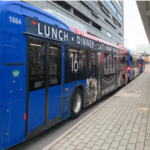Solve the I-70 ski-traffic nightmare with mountain trains
In December, passengers on the inaugural Snowstang to the Arapahoe Basin ski area spent around five hours getting to the slopes and even longer returning to Denver. During the Martin Luther King holiday weekend, drivers reported trips upwards of six hours from Denver to Silverthorne. Our governor, Jared Polis, reported a six-hour return trip from Vail on a Sunday evening last year.
Every weekend, there is another traffic meltdown on the Interstate 70 corridor to the mountains. There is frustration, road rage, defeat, and at times calls from the Colorado Department of Transportation to avoid that road altogether. Regardless of whether or not you make regular trips to mountain destinations, our economy and quality of life hinge on those trips. Something’s gotta give.
There is tourism and all of its economic impacts. The I-70 corridor is a vital economic lifeline for the state. Tourism supports more than 174,000 jobs in Colorado, according to Visit Denver’s 2018 statistics. Because of the $1.4 billion in state and local taxes paid annually by visitors, every Colorado households save hundreds of dollars annually in taxes. The outdoors, recreation, and enjoyment of the mountains are chief among the reasons to move and stay here.
The reality is that we have outgrown that highway. At the time it was planned and built in the 50s and 60s, the anticipated population growth was 3 million statewide by the 1980s. We have doubled that, and we continue to grow at a rate of 7% per year. The Colorado Department of Transportation estimates that westbound I-70 travel times will triple by 2035; eastbound drivers should expect their commutes to quadruple. It’s bleak and something’s gotta give.
The temptation is to widen the road, yet history proves that single-mode, single-path transportation — cars, buses, shared rides or even driverless vehicles all relying on the same highway — is unsustainable and impractical. All of our eggs are in one basket, a few-lane basket that traps all drivers and passengers whether they ride in the Snowstang or a single-occupancy SUV.
Rail is a proven, cost-effective alternative that moves a high volume of people in a reliable way over significant distances. The most advanced transportation systems in the world focus on modern rail as the most effective, environmentally responsible way to move people at scale. China has added 20,000 miles of high-speed rail (to 500 in the U.S.) while Germany recently committed $70 billion to modernize its rail system to combat climate change.
It is tempting to throw our hands up in the air and say we cannot do that mostly because the Taxpayer’s Bill of Rights (TABOR) passed in 1992. TABOR paralyzes government spending on infrastructure. It is also tempting to say that voters have rejected the last three ballot measures that addressed transportation. But we cannot afford to do that. Coloradans don’t like blank checks to an agency like CDOT, and they were never asked to invest in a train to the mountains. It may be time we ask the specific question, and it may need to be focused on only some of the taxpaying population of the state that will more directly benefit from such a project. A success story is Fastracks, a transit specific ballot initiative that was overwhelmingly approved by the voters in 2004.
The good news for a project like that is that we don’t need to start from scratch. The train line to Winter Park provides a great jumping-off point. The most expensive section of track under the continental divide is already in place and the opportunity is there to build a line to Silverthorne with potential additional spurs to other mountain towns.
The train to Winter Park sold a record 19,200 tickets last season. Service expanded this year. Amtrak’s double-decker express takes snow enthusiasts from Union Station to Winter Park in two hours, dashing through 31 tunnels over 66 miles of tracks. Those arriving at Denver International Airport can take the 37-minute A Line rail service to Union Station for $10.50. This is currently the only situation in North America where you can fly into an airport and take rail all the way to the slopes.
An added opportunity of this existing train is to quickly relieve traffic by improving the existing train and increasing service. Each train carries more than 500 passengers. Currently, service operates between January 10 through March 29 with one departure each way per day, on Fridays, Saturdays, and Sundays. Investing in modern features, from internet, usb and power outlets, dining and bar cars, and offering more options on timing will be money well-spent in the effort to take more cars off the road between Morrison and Empire on I-70. Subsidizing part of the cost of the tickets to keep it accessible to all, will further incentivize ditching one’s car.
The train does not replace the current bus service. The Snowstang is a welcome addition to the limited options, but its impact is minimal. The 51-seat buses to Loveland and A-Basin have been running 49% full, with the bus to Steamboat running 30% full, according to CDOT. Only 40% of costs are covered through rider fares, the rest being subsidized by the ski areas involved, a move that should be replicated to some extent for a train service.
The difference between trains and buses+ is reliability, the potential for frequency, along with significantly more capacity to actually make an appreciable impact on traffic counts.
Broader benefits of a train are not to be overlooked: fewer cars lead to better air quality at a time when clean air is a major priority for our state. Fewer cars will also be a relief for small mountain towns currently overrun with them, crippled by the traffic and parking shortages they create. Unlike a road expansion, building a train will not place additional pressures on traffic and the surrounding communities as a result of construction crews.
Technology hounds drool over big shiny ideas like the Hyperloop. That is not a solution for our I-70 woes. The concept is not as revolutionary as originally presented, not proven, and not designed to move significant numbers of passengers but rather as a side-kick project to Tesla automobiles. Pursuing partnerships with operators who have an interest in investing in infrastructure can be one answer to our funding gaps. One such operator is Virgin and its project in Florida is an example. As service takes off from Miami, Fort Lauderdale, West Palm Beach and beyond, Florida will likely have the fastest rail travel in the United States. We could too.
During the State of the State address earlier this month, Gov. Jared Polis aptly described our charge as Coloradans: “By investing in our infrastructure and providing more affordable and convenient transportation options, we can relieve traffic congestion, reduce harmful emissions that blacken our skies, and also boost our entire economy.” A train to the mountains fits the bill. Let’s encourage, empower, and support our leaders to get it done.
![DRMAClogo[1] DRMAC](https://drmac-co.org/wp-content/uploads/2019/12/DRMAC20logo1.jpg)



